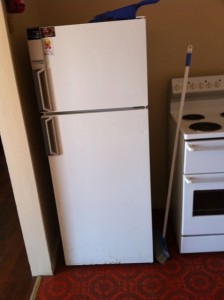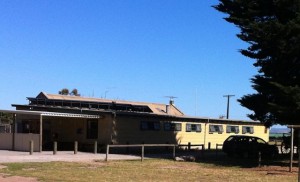I had a cracking couple of days at Narnu farm, 1hr south of Adelaide, a coupla weeks ago.
We go there with the kids who love it. It’s a hobby farm where the kids can feed the animals and go horse riding and all that good stuff.
As soon as you drive in, you can’t help but notice their 2kW Solar System made up of about 30 60W Kaneka Solar Panels on the roof of the office building.
So is this blog post going to be singing the owners’ praises for getting solar and doing their bit for the planet?
Short answer: no.
Being the grumpy old contrarian that I am, I’ve got 2 big problems with this particular install.
Here’s the first error with this install:
This photo of the solar system (see the panels on the roof on mounting frames) was taken at 10:30 in the morning. Can you spot the problem?
The tree on the right is casting a bloody huge shadow across almost all the panels! Ouch!
That’s bad. However my real problem with the install is this:
They have made zero attempt at energy efficiency before or after installing solar.
It is about five times cheaper to perform energy efficiency than it is to install solar to save the same amount of electricity.
So, although solar is a wonderful thing, you should always do everything you can to maximise the energy efficiency of your home or business first.
Here are some examples of really bad energy wastage that could have been addressed with minimal time or investment:
1) They are still using incandescent bulbs! Check out the photo – I haven’t seen these old things in years.
I counted about 16 of these energy guzzling devices of satan. Let’s do some really simple sums:
Assume each one is on for 4 hours per night (a conservative assumption – I saw lots of them left on all day).
The amount of energy they will consume in 1 year is: 60W x 4 hours x 365 = 87.6kwh per year per bulb = 1401.6kwh per year total.
A CFL bulb will use about one tenth of the electricity of the incandescents, so they are wasting about 1250kWh per year, for the sake of spending about $60 on new bulbs.
That energy that is being wasted is probably close to the amount of electricity generated by 1kW of solar panels – half of their solar system!
Next: Check out the fridges…

A modern fridge of a similar size can be had for about $500 and will use a quarter of the electricity!
So for about $3,000 they could be saving about 3000kWh per year. That combined with the bulbs should easily give them energy savings greater than the output of their entire solar system (which probably cost them about $20,000 when they bought it).
Other shockers which should have been replaced are the antique window rattler Air Conditioners and the electric storage hot water systems. The latter is especially crazy for accommodation that is most likely empty for many weeks a year, because you get hot water whether the place if fully occupied or not.
The moral of the story is: Yes – solar is fantastic. But before you get that solar system at least do the most basic energy efficiency measures: i.e. bulbs, appliances, hot water, draft sealing, window shading… Otherwise you are getting a much bigger system than you really need.
A good solar installer will talk you through all this before selling you a system.



 RSS - Posts
RSS - Posts



I proceeded through several steps before purchasing my solar panels, changing the light bulbs to the compact fluorescents globes. Switching off TV Entertainment system at the wall, removing the 275 watt heat lamps from the bathroom, finding better replacements for the radiators in the kids bedroom.
After I made the house efficient as I could then the purchase of the solar panels was made.
The way I see it, on a typical summers day my solar installation can generate 30 kw/h of electricity. This energy is best used being supplied to the grid, reducing my neighbours draw on the carbon producing power station.
Hi Finn just thought I would drop you a line see if you can shed any light pardon the pun. I recently been contacted by a company called Kleen Energy Enterprises 586 Regency Road, Broadview SA 5083
T: 133 SOLAR (133 765) F: 1300 924 094
PH: (08)70702736
in 2009 we had a company called Solar shop Australia install 21 panel thin film Kaneka system to our house in Bankstown Sydney. KEE have advised us that our panels have a negative earth fault which may lead to corrosion of the electrical terminals and are susceptible to corrosion does this sound correct they have sent an email stating for $440 they can install an earthing kit to rectify the problem. Does this sound like a design fault in the panels , any ideas would be much appreciated.
Hi William,
If you have Kaneka panels, then they need to be negative earthed. If you have an SMA inverter the earthing kit costs about $105. Total cost for installation and labour should be about $250. A local solar installer should be able to arrange it for you at close to that price.
Hope That Helps,
Finn
Hi Finn,
If we get a local installer other than Solar shop Australia, will this be non-compliant with them and void the warranty? The old Solar Shop Australia went under receivership for some time and the new firm Clean Energy Enterprise using the same retail name wants $440 to rectify the earthing problem and for continuation of warranty. Is Clean Energy obligated to continue with warranty regardless of who fixes the problem? Would appreciate your early reply.
Kim
Clean Energy are not obligated to honour the warranties of anyone who bought from the original Solar Shop.
The manufacturers of the panels and inverter are, however. SO if you have a problem in the future go straight to the manufacturer.
Under Australian Consumer Law you can have anyone who is qualified service your solar system without voiding the manufacturer’s warranty. Just like Holden can’t void your warranty if your local, non-Holden mechanic services your car.
I too have been contacted by Kleen energy enterprises, and say i need to get my inverter negative earthed, i feel if this should have been done when installed, it should be fixed by no cost to me, i don’t know what to do about this, can any one tell me what i should do?
er,,,,,,no, I couldn’t “Can you spot the problem?” because of the shadow thrown by that bloody great tree. 🙂
But, while I’ve been meticulously employing the ‘efficiency’ rules for decades, I rather think you’re going a bit overboard with your arithmetical considerations.
eg.:- incandescent globes. If the globes which they already own are doing the job required, and their already-owned solar-system are providing all the power needed, why should they spend more money on something they don’t need.
The same thing applies to the fridge.
If all the efficiency measures were installed ~ at no small cost ~ then despite all the numbers you’d be producing excess power to no purpose.
Remember the old maxim:- If it works, don’t fix it!
(Though I’d make an exception in reducing the tree to where it didn’t interfere with the potential insolation.)
ps. in my experience incandescent globes last longer than the ‘energy-saving’ ones. Ditto the older fridges. There was a day when NOTHING was made to be ‘throw-away’, unlike today, when mass-producing industries need to achieve a continuing/increasing ‘demand’. (like the power industries, for example.)
One example that I often think about is the 45-watt panels I bought 2nd-hand in the early ’80s, which are STILL producing about 38 watts. Despite the promises of often-transient solar businesses I wonder how well panels sold today will be performing in 35 years.